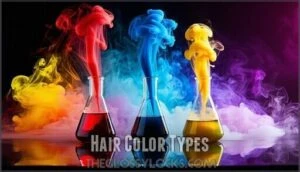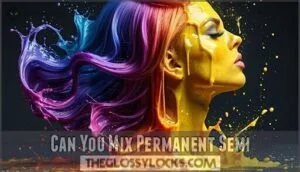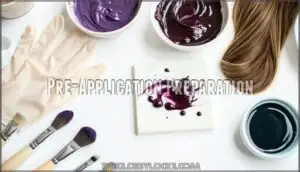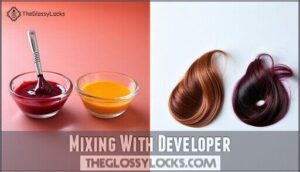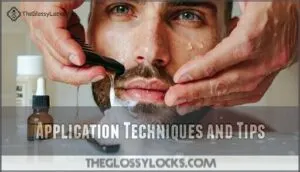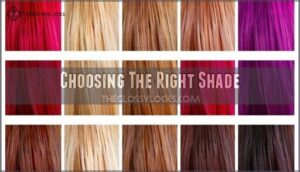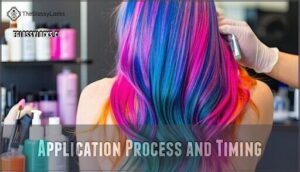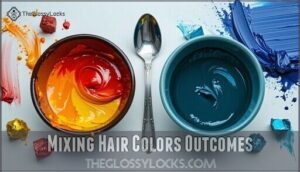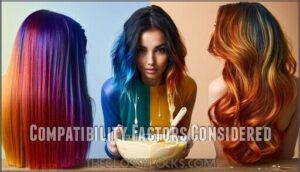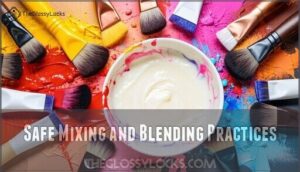This site is supported by our readers. We may earn a commission, at no cost to you, if you purchase through links.
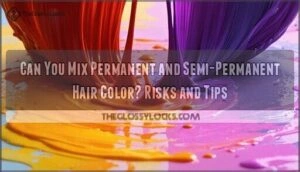
Permanent dyes rely on peroxide and ammonia to penetrate the hair shaft, while semi-permanent colors simply coat the surface without any chemical reactions.
Combining them can lead to uneven color, weird chemical reactions, or even damage your hair’s texture.
It’s like trying to bake a cake with pizza dough—not ideal!
If you’re after a unique shade, stick to blending dyes of the same type, or consult a professional for safe results.
Curious about the best way to mix colors?
There’s definitely a right way.
Table Of Contents
- Key Takeaways
- Hair Color Types
- Can You Mix Permanent Semi
- Permanent Hair Color Application
- Semi-Permanent Hair Color Application
- Mixing Hair Colors Outcomes
- Compatibility Factors Considered
- Expert Opinions and Recommendations
- Safe Mixing and Blending Practices
- Frequently Asked Questions (FAQs)
- What happens if you mix a semi-permanent and a permanent dye?
- Can you use semi permanent dye over permanent dye?
- Does semi permanent hair dye work?
- Can you mix permanent and Demi-permanent hair dye?
- Can You Put semi permanent dye on wet hair?
- Does semi permanent hair dye have peroxide?
- What Are the Pros and Cons of Permanent Dyes?
- What Are the Pros and Cons of Semi-Permanent Dyes?
- How Long Does Permanent Dye Last?
- How Long Does Semi-Permanent Dye Last?
- Conclusion
Key Takeaways
- Don’t mix permanent and semi-permanent dyes—they’re chemically incompatible and can cause uneven color or damage.
- Permanent dye alters your hair’s pigment with ammonia and peroxide, while semi-permanent coats the surface and fades naturally.
- Use semi-permanent dye over permanent color only to enhance or tone, but avoid mixing them together.
- For safe, unique results, stick to blending dyes of the same type or consult a professional.
Hair Color Types
Understanding the types of hair color is essential before mixing them. Permanent and semi-permanent dyes work differently, so it’s vital to know their characteristics to avoid unexpected results.
Permanent Hair Color Characteristics
Permanent hair color lasts long by penetrating the cuticle and altering your hair’s pigment, offering excellent gray coverage.
Permanent hair color transforms your look by deeply altering your hair’s pigment, delivering vibrant tones and unbeatable gray coverage that lasts.
Its chemical composition, including peroxide and ammonia, makes hair lightening possible.
Unlike semi-permanent dye, it stays put, only growing out with your hair, and when considering permanent vs semi highlights, major compatibility hurdles arise due to differing formulas, so be cautious when mixing hair dyes, as this can lead to significant issues with the final result, particularly in terms of color consistency and hair lightening.
Semi-Permanent Hair Color Characteristics
Semi-permanent dye sits on the surface of your hair shaft rather than penetrating deeply.
It’s great for experimenting, as it fades naturally over six weeks, leaving no harsh lines.
Offering vibrant tones with minimal damage, it’s ideal for temporary color or toning highlights.
Unlike permanent hair color, it won’t lighten or completely cover grays, ensuring easy, low-commitment application.
Many users find that shade selection matters for desirable results, which is a key factor in achieving the desired temporary color and toning highlights.
Key Differences Between Permanent and Semi-Permanent
When choosing between permanent hair color and semipermanent dye, understanding their differences helps with hair color compatibility.
Permanent dye penetrates the hair shaft, lasts longer, and fully covers grays. Semipermanent hair dye coats the surface, offering temporary color.
- Longevity Comparison: Permanent outlasts semipermanent.
- Color Penetration: Permanent alters natural pigment.
- Gray Coverage: Permanent guarantees coverage.
- Chemical Composition: Permanent contains ammonia, risking hair damage.
Can You Mix Permanent Semi
Mixing permanent and semi-permanent hair dyes might seem like a creative idea, but it often leads to unpredictable results.
Their chemical differences can cause uneven color, rapid fading, or even hair damage.
Risks of Mixing Permanent and Semi-Permanent Dyes
Mixing permanent and semi-permanent dyes sounds tempting but can lead to unpredictable results.
Chemical reactions between their formulas often cause color fading, patchiness, or even cuticle damage. Over time, this weakens hair strands, increasing the risk of hair breakage.
For safe hair dye compatibility, stick to one type. Mixing risks hair damage and creates outcomes that aren’t easy to fix.
Chemical Reactions and Incompatibility
When combining permanent and semi-permanent hair color, the results can be unpredictable due to formula incompatibility.
Hair dye compatibility issues often cause color blocking or strange tones.
Semi-permanent dyes can’t handle developers, leading to reaction unpredictability and ineffective results.
These incompatible dye ingredients may even cause cuticle damage.
Always follow hair dye mixing rules to prevent disappointing outcomes.
Potential Damage to Hair
Mixing permanent and semi-permanent dye can wreck your hair’s health.
Harsh chemicals cause hair damage, worsening over time.
Watch out for these risks of hair color damage:
- Cuticle Damage: Opens your hair, leading to breakage.
- Hair Breakage: Weak strands from chemical overload.
- Uneven Color: Results from incompatible formulas.
- Rapid Fading: Semi-permanent dye quickly washes out.
Permanent Hair Color Application
Applying permanent hair color requires careful preparation to guarantee even results and minimize damage. You’ll need to mix the dye with a developer correctly and follow precise steps for application.
Pre-Application Preparation
Before hair color mixing, get organized.
Inspect your hair’s condition and do a strand test to predict results. Check skin sensitivity with a patch test to avoid irritation.
Prepare tools and set up a clean workspace. Use gloves, clips, and brushes for neat application. A proper hair analysis is useful before proceeding.
Here’s a quick guide:
| Step | Action | Why It’s Important |
|---|---|---|
| Hair Assessment | Check texture & health | Avoid unwanted damage |
| Strand Test | Test a small section | Confirm desired results |
| Skin Sensitivity | Patch test with dye | Prevent allergic reactions |
| Tool Preparation | Organize gloves, clips | Streamline application |
Mixing With Developer
Before opening your permanent hair color, remember that hair dye developers work in specific volumes.
Stick to the mixing ratios on the box—usually 1:1 or 1:2. Too much or too little developer impacts color deposit.
Always strand-test before full application to check results. Application timing matters—over-processing can damage hair, while under-processing mightn’t fully develop the hue.
Application Techniques and Tips
Before applying permanent hair color, focus on Pre-Application Prep. Always start with clean, dry hair, and section it into manageable parts for even coverage.
Follow the dye mixing guide for accurate mixing ratios. Apply evenly, avoiding over-saturation. Remember to detangle hair thoroughly before starting the coloring process.
A cool rinse seals the color and prevents damage. Post-Coloring Care includes using conditioner to maintain hair health and vibrancy, which is a crucial step for long-lasting results.
Semi-Permanent Hair Color Application
When applying semi-permanent hair color, it’s important to start with clean, damp hair to guarantee even coverage.
Follow the instructions carefully, as leaving the color on too long or applying unevenly can lead to unexpected results, and remember to always apply the color carefully.
Choosing The Right Shade
When choosing a semi-permanent hair color shade, consider how it fits your skin tone and undertones.
Don’t forget your hair history and personal style for realistic hair color results.
To pick the perfect match:
- Match shades to your natural undertones.
- Choose based on lifestyle factors.
- Test subtle hues before bold changes.
- Consider manageable, gradual hair color change.
This process will help you achieve a hair color that complements your overall appearance and is easy to maintain, ensuring a realistic and satisfying result.
Application Process and Timing
Start with clean, damp hair to guarantee even coverage. Section your hair for precise application, working from roots to ends.
Semi-permanent dye timing matters—leave it on for 15-30 minutes, depending on desired intensity. Stick to the instructions, avoiding shortcuts. Processing duration affects color development and outcomes.
Many seek products for semi permanent application. Follow color mixing rules to prevent unwanted hair color chemical reactions, ensuring the best semi-permanent results with proper application.
Post-Application Care and Maintenance
Use a color-safe shampoo and deep conditioner to extend your semi-permanent color’s life.
Hydration is key—consider a weekly deep conditioning mask.
Avoid heat styling, as it can fade the hue faster.
UV protection is essential, so cover your hair outdoors.
For maintaining your color, consider using products for color.
Stick to gentle hair washing routines, and always prioritize hair care to maintain vibrancy.
Mixing Hair Colors Outcomes
Mixing permanent and semi-permanent hair dyes can create unique, multidimensional shades, but the results are often unpredictable.
You might encounter uneven fading or clashing tones due to the chemical differences between the two formulas, which can lead to uneven fading.
Unique and Multidimensional Shades
Blending semipermanent hair color with permanent hair color might seem like a fun way to create Custom Color Blending or achieve Multi-Tonal Effects.
Unique Dye Combinations can lead to unexpected Shade Creation, offering stunning hair color multidimensional results.
However, without professional Dimensional Color Techniques, results can be unpredictable. Some hair dye shades mightn’t complement each other, and inconsistencies in application could limit the seamlessness you’re aiming for with hair color blending.
To achieve a unique shade, consider how tertiary colors are created.
Uneven Fading and Color Clashing
Mixing permanent and semi-permanent hair dye might seem harmless, but uneven fading and shade mismatch can leave your color looking patchy.
Chemical interactions between formulas often clash, leading to unpredictable color results. For reliable results, stick to a single dye type.
- Color Undertones: Mixed dyes may create undesired undertones.
- Patchy Results: Uneven application occurs often.
- Fading Issues: Semi-permanent dyes fade faster, disrupting blends.
- Color Correction Challenges: Fixing mismatched shades can damage hair further.
Compatibility Factors Considered
When mixing permanent and semi-permanent hair colors, you need to take into account their different chemical compositions and purposes.
These differences can lead to unpredictable reactions, potentially affecting the final color and your hair’s health.
Chemical Ingredients and Purposes
The ingredients in hair dye formulas vary, particularly between permanent and semi-permanent color.
The differences in these formulas affect chemical reactions. Permanent hair color employs ammonia and peroxide for deep penetration, while nonoxidative dyes in semi-permanent rely on gentler chemicals.
| Type | Key Ingredient | Purpose |
|---|---|---|
| Permanent Dye | Hydrogen Peroxide | Alters natural pigment |
| Semi-Permanent Dye | Coal-Tar Dyes | Adds surface-level color |
| Developer | Ammonia | Opens hair cuticle |
These differences are crucial in understanding how hair dye works, and the role of key ingredients in the process.
Blocking Development of Permanent Colors
Permanent hair color relies on a developer to activate and penetrate the hair shaft.
When mixed with semi-permanent dye, incompatible ingredients can cause chemical interference, blocking proper color development.
This can leave you with unpredictable results, like ruined semi-permanent or permanent hair color, causing unnecessary frustration during your hair-dyeing adventure, which is why it’s essential to use each type separately.
Unpredictable Chemical Reactions
When combining permanent and semi-permanent hair dye, the varying chemical composition creates instability.
These formula incompatibilities can cause dye interactions that result in unpredictable results—like uneven tones or strange shifts in hair color.
The damage potential is real, as unseen results often stem from the chemical instability.
Mixing hair dye this way is risky for both your hair’s health and appearance.
Expert Opinions and Recommendations
Experts recommend sticking to one type of hair dye rather than mixing permanent and semi-permanent formulas.
Combining these can lead to unpredictable results, so it’s safer to consult a professional or explore other options, as this approach helps avoid potential damage and ensures a safer application.
Advice Against Mixing Dyes
Hair dye advice from the pros is clear: don’t mix permanent and semi-permanent dyes. The results can be unpredictable and damaging. Stick with safe blending techniques and remember hair color mixing risks are real.
- Chemical reactions may harm your hair.
- Mismatched formulas disrupt developer volume needs.
- Hair damage risk skyrockets with incompatible mixes.
- Always consult a color wheel for guidance.
Safe Alternatives and Options
If you’re seeking vibrant tones or a temporary change, try veggie dyes, color depositing products, or henna alternatives.
Temporary sprays and color washes offer options without risking hair damage.
These are safe, versatile, and avoid issues with hair dye compatibility, always consider hair color ingredient differences and follow hair dye advice for the best results—safety first, fun second!
Professional Guidance and Consultation
Consulting a professional hair stylist brings peace of mind when you’re unsure about color choices.
Most salons have strict mixing policies to protect your hair’s health and achieve predictable results.
One key aspect of maintaining colored hair is to use bond-rebuilding treatments for hair repair.
- Personalized Color Analysis – Stylists assess your hair’s condition, porosity, and current color to recommend safe options
- Expert Application Techniques – Professionals know proper timing, sectioning, and product combinations for superior results
- Salon Mixing Policies – Most establishments prohibit mixing incompatible dyes to prevent damage and unpredictable outcomes
Safe Mixing and Blending Practices
You can safely mix hair colors if you stick to dyes with similar depth levels and chemical compositions.
Use tools like tinting brushes and conditioners to guarantee even application and avoid harmful reactions.
Mixing Similar Depth Levels
Matching the depth levels of hair dye is key for smooth results.
Stick to similar shades when blending to avoid uneven tones.
Follow Color Wheel Guidance to guarantee complementary tones mesh well.
Use the right hair color developer for consistency.
Ignoring Depth Level Matching disrupts balance, risking patchy results and faster fading—simple Shade Blending Tips guarantee a pro finish.
Using Tinting Brushes and Conditioners
When mixing hair colors, a good tinting brush and conditioner can work wonders.
These tools guarantee even blending and soften the mixture for smoother application.
Here’s how to optimize your process:
- Use a hair dye tinting brush for consistent coverage.
- Add conditioner to enhance hair dye benefits.
- Match shade depth for uniformity.
- Apply small sections to avoid streaks, ensuring a uniformity that is key to a successful hair coloring process.
Avoiding Incompatible Chemical Formulas
Not all hair dyes play well together! The chemical composition of permanent and semi-permanent dyes can clash, causing unintended results.
Formula compatibility factors matter—mixing them might trigger chemical reaction risks, ruining the color or damaging your hair.
Stick to professional dye analysis and always check dye ingredient interactions to prioritize hair color safety over experiments to avoid neutralizing unwanted tones mistakenly.
Frequently Asked Questions (FAQs)
What happens if you mix a semi-permanent and a permanent dye?
Imagine oil and water trying to mix—permanent and semi-permanent dyes clash similarly.
Their chemicals don’t play well together, leading to uneven color, strange patches, or even damage.
Stick to one type for better results.
Can you use semi permanent dye over permanent dye?
You can use semi-permanent dye over permanent dye to refresh or tweak your color.
Just pick a shade close to or darker than your current tone.
It won’t lighten the existing permanent color, so you can safely choose a darker shade without worrying about the outcome.
Does semi permanent hair dye work?
Picture a gentle rain coating the surface of leaves—that’s how semi-permanent dye works.
It doesn’t penetrate hair deeply but adds a vibrant layer of color.
It’s temporary, fades gradually, and avoids harsh chemicals.
Can you mix permanent and Demi-permanent hair dye?
Mixing demi-permanent and permanent hair dye isn’t recommended.
They’ve got different chemicals and purposes, which can react unpredictably.
Instead, layer them separately for healthier results and more control over your desired shade.
This approach allows for healthier results and more control over your final appearance.
Can You Put semi permanent dye on wet hair?
Think of your hair like a sponge—it absorbs differently when wet.
While you can apply semi-permanent dye to wet hair, it might dilute the color, leading to less vibrant results.
Dry hair guarantees better coverage.
Does semi permanent hair dye have peroxide?
Semi-permanent hair dye doesn’t contain peroxide, so it won’t chemically alter your natural color.
Instead, it coats your hair’s surface, creating a temporary shade that gradually fades after several washes.
What Are the Pros and Cons of Permanent Dyes?
Permanent dyes, like a tattoo for your hair, offer lasting color but can damage strands without proper care.
They deeply penetrate the hair, ensuring coverage, but require commitment, touch-ups, and chemical exposure.
Use wisely.
What Are the Pros and Cons of Semi-Permanent Dyes?
You’ll love semi-permanent dyes for their gentle, temporary color changes.
They don’t damage hair since there’s no ammonia or peroxide, but they fade quickly after a few washes.
Perfect for experimenting without long-term commitments!
How Long Does Permanent Dye Last?
Permanent hair dye lasts until your hair grows out or you cut it.
Typically, roots will show within 4-6 weeks, so touch-ups are needed regularly to maintain that fresh, flawless color.
How Long Does Semi-Permanent Dye Last?
Ever wonder how long semi-permanent hair dye sticks around? Typically, it lasts 4 to 8 washes. It fades gradually, so use gentle shampoos and cooler water to stretch its vibrancy for longer.
Conclusion
Mixing permanent and semi-permanent hair colors is like combining fire and ice—it’s a recipe for disaster.
The chemical differences between the two can lead to unpredictable reactions, uneven results, and even hair damage. If you’re tempted to experiment, resist!
Stick to dyes of the same type to keep your hair healthy and your color vibrant.
Remember, regarding hair color, safety matters. Consult a professional if in doubt—your hair will thank you.
- https://www.coloredhaircare.com/can-you-mix-permanent-and-semi-permanent/
- https://www.tiktok.com/@slashndye/video/7463586961509420330
- https://www.reddit.com/r/HairDye/comments/r4zmw5/mixing_permanent_with_semi_permanent/
- https://forums.soompi.com/topic/253643-mixing-permanent-hair-color-with-semidemi/
- https://www.quora.com/Can-you-mix-semi-permanent-hair-colour-with-regular-permanent-hair-colour

